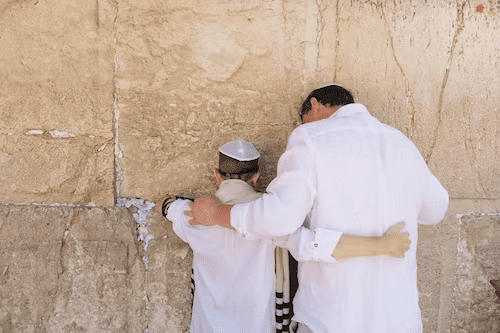
A Sacred Site for People All Over the World
The Western Wall, also known as the Wailing Wall or “the Kotel” in Hebrew, stands as a revered and sacred site not only for the international Jewish community, but also for people of different faiths and backgrounds. It holds a universal appeal that transcends religious boundaries, attracting individuals who want to have their voices heard, and that are seeking solace, connection, and a sense of spirituality.
Over the years, the Western Wall has gained immense historical and cultural significance. It is a relic of ancient times, holding within its stones the collective memory of Jerusalem and its rich, spiritual past. The Wall represents an opportunity to travel back to an ancient era, a tangible link to a time when humanity was more directly connected to God.
The Western Wall is also a symbol of resilience and hope. For many, it’s a testament to the indomitable spirit of a people who endured centuries of challenges and hardships, and yet persevered. The Wall embodies the survival of a culture and its faith,against all odds, inspiring admiration and respect from individuals of diverse backgrounds, who identify with the triumph of the human spirit over adversity.
Moreover, the Western Wall holds a special place for Christians. It’s considered part of the remnants of the Second Temple, which was renovated shortly before the birth of Jesus Christ, and then destroyed shortly after his death. Followers of Jesus Christ often visit the Wall to connect with the roots of their faith and gain a deeper understanding of the historical and religious context in which Jesus lived and preached. They come to the Wall to pray, reflect, and seek a spiritual connection to their beliefs.
The Western Wall is a place of interfaith dialogue and understanding. In a world that is increasingly interconnected, individuals from various denominations view the Wall as a symbol of unity and peace. It serves as a common ground for people of different faiths to come together, to pray for peace, and to foster understanding and respect for one another’s beliefs.
Above all, the Western Wall is a place of personal prayer and reflection for anyone seeking solace or guidance. Regardless of their beliefs, people often turn to this revered site in moments of distress, seeking comfort and hope in the midst of life’s many challenges. The powerful spiritual aura of the Wall provides a sense of reassurance and peace to those grappling with personal struggles.
Thus, the Western Wall serves as a unifying force, attracting people from all over the world, of all backgrounds and beliefs. Its historical, cultural, and spiritual significance makes it a place of devotion and attachment, where individuals from diverse walks of life can find meaning, peace, and a deeper understanding of themselves and their connection to God.

